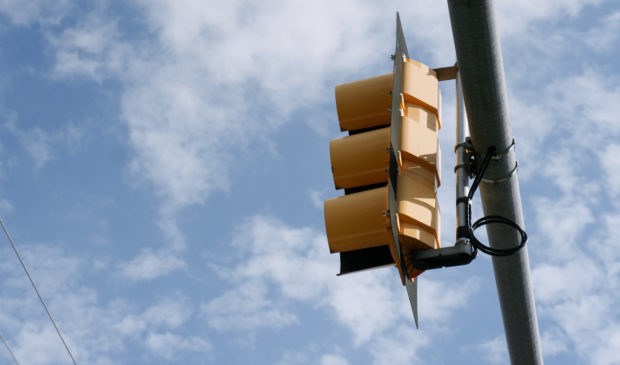Dark traffic signals lead to havoc, hazards across Austin
Wednesday, February 8, 2023 by
Kali Bramble As thousands awaited relief from dayslong power outages this past weekend, motorists, cyclists and pedestrians encountered hazards of another sort, as hundreds of stoplights went offline across the city.
Richard Mendoza, the interim director of the city’s Transportation Department, addressed the situation at a Tuesday press conference.
“Approximately 40 percent of our traffic signals were impacted by the storm, either by loss of communications or by loss of power. Since that time, our crews have been working around the clock and we’ve been able to restore all but five traffic intersections and all but one … crossing signal,” he said, noting that those five traffic signals “were at least on flash operations” and displaying flashing red lights.
Transportation Department staff reported 118 traffic lights gone completely dark at the outage’s peak, with many on main thoroughfares like North Lamar, South Congress, and Parmer Lane, as well as at major intersections near MoPac Expressway, Interstate 35, and highways 290, 360 and 183. While traffic laws dictate that drivers treat offline traffic lights as a four-way stop, many reported close calls and even collisions as cars barreled through intersections, particularly at night.
Not all went out immediately – around half of Austin’s 1,000-plus traffic signals are equipped with batteries that can power intersections for up to six hours of lost power. But this small boost was no match for the devastation wrought by the storm, which left behind a tangled mess of downed trees and utility poles that the city estimates will not be fully repaired until as late as Sunday.
Complicating matters were communication failures at Austin’s Mobility Management Center, which lost contact with 491 signals due to interrupted fiber optic cable networks and forced ATD to dispatch staff for on-site assessments before mobilizing repairs. ATD’s traffic signal monitoring dashboard shows 81 stoplights still awaiting reconnection to the management center, though as of Monday only four remained dark.
As Austin Energy crews and mutual aid contractors worked around the clock to restore power to residences, those braving dark streets were left wondering: Where was city leadership? In a statement to The New York Times, City Manager Spencer Cronk asserted that temporary stop signs had been installed at 30 offline traffic signals, but after days of havoc, the efforts seemed few and far between.
The Austin Police Department was also largely quiet; though ATD claims some officers were deployed to direct traffic, last Friday APD told KUT news that “no officers were available to direct traffic at busy intersections” as they were busy with more serious calls.
“This was a significant event, and I think that on Wednesday morning people saw there were trees down and there was ice on trees, but they didn’t know the extent of it. So something I really take away is ‘How can we do a better job of showcasing to our community the damage that really was impacting all parts of our community?’” Cronk said Tuesday. “You could see outside of your window, but you didn’t necessarily know the extent of that damage until a couple days later.”
According to city data, crashes rose threefold from last year in the days immediately following the storm. Travis County EMS reported continuing spikes in collisions through the weekend, well after the thawing of icy roads.
ATD says it is exploring technological solutions to power intersections through extensive outages, but is unaware of any on the market. The department might look to Florida’s Hillsborough County, where officials facing frequent hurricanes have installed a network of solar-powered power outage emergency beacons that flash red when signals fail. The cost of each beacon, or POEB, ranges from $20,000 to $30,000.
On Tuesday, Mendoza urged the community to report any dark signals that were impacted by the ice storm or ongoing thunderstorms by calling 311. In the meantime, he reminded drivers that flashing red or non-working traffic signals should be treated as a four-way stop. In addition, he noted that school zones should be observed, even if lights accompanying signage are out.
Photo made available through a Creative Commons license.
The Austin Monitor’s work is made possible by donations from the community. Though our reporting covers donors from time to time, we are careful to keep business and editorial efforts separate while maintaining transparency. A complete list of donors is available here, and our code of ethics is explained here.
You're a community leader
And we’re honored you look to us for serious, in-depth news. You know a strong community needs local and dedicated watchdog reporting. We’re here for you and that won’t change. Now will you take the powerful next step and support our nonprofit news organization?











